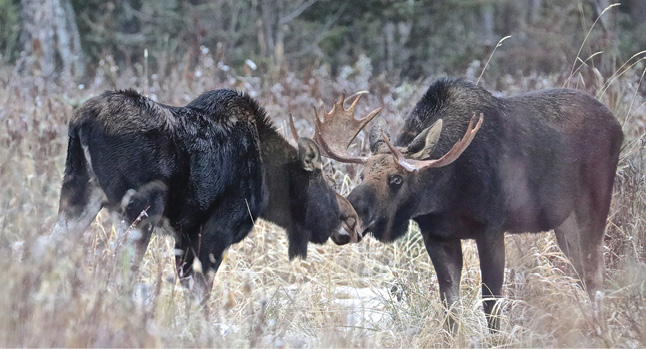For the second time in its 55-year history, this year’s annual North American Moose Conference and Workshop (NAMCW) is set to take place in Grand Portage during the week of May 22-26.
The NAMCW is hosted in a different location each year, and was last held in Grand Portage back in 1999. The conference is an opportunity for experts in the field to come together to discuss, share, and collaborate on all-things moose—the world’s largest extant (i.e. non-extinct) species in the deer family and a symbol of boreal forests across the planet.
“As you can imagine,” says Steve Windels, a wildlife biologist at Voyageurs National Park and one of two co-directors for this year’s conference, “moose make up a very focused part of wildlife biology.”
“Moose’ range is circumboreal,” continues Windels, “meaning its territory spans boreal forests across North America, Europe, and Asia, so we typically get a mix of professionals at these events; both national and international ‘moose enthusiasts’ from anywhere that there are moose.”
The 2023 conference is being hosted by the Grand Portage Band of Lake Superior Chippewa at the Grand Portage Lodge and Casino. Seth Moore—the Director of Biology and Environment with the Grand Portage Band of Lake Superior Chippewa—is co-directing the event with Windels, serving as the conference’s “local” director/organizer.
Events at this year’s conference include a day and a half of technical presentations, a workshop on “Indigenous Co-Stewardship and Co-Management of Moose and Other Wildlife,” a full-day field trip to Grand Portage Band wildlife research field sites, and a tour of the Grand Portage National Monument.
There is also an optional pre-conference day trip out to Isle Royale that can be registered for separately on the conference’s website.
According to Windels, they are expecting a number of international attendees from Canada to participate at the conference, with the possibility of “scientists and managers from parts of Scandinavia” taking part in the event as well. Past conferences, specifically those held in Alaska, have included attendees from as far afield as Mongolia and Russia.
“There is no organizing body coordinating the conference each year,” says Windels, “no nonprofit or for-profit organization driving this effort, which is part of what makes this event unique.”
“It’s really just a group of passionate people,” continues Windels, “coming together to share and learn about moose, carrying on a tradition of collaboration that started in the 1960s.”
The first North American Moose Conference took place in St. Paul in 1963. The conference came about as a result of the combined effort of Pat Karns and Al Elsey—well known wildlife biologists and conservationists for the Minnesota DNR and Ontario Ministry of Natural Resources, respectively.
According to an article in alcesjournal.org written by Vince Chricton entitled The Founders: A Tribute to Pat Karns and Al Elsey, the NAMCW “spawned” from a series of phone calls between the two prominent moose experts.
Elsey was a big proponent of interagency cooperation, and took initiative to set up the initial meeting with Karns across the border. After the success of the first conference in 1963, Elsey, according to Chricton, went so far as to grant Karns a free Ontario moose hunting license to “ensure Pat’s continued interest and participation” in future conferences.
The topics covered in those initial conferences—moose population counting/estimating, the impacts of hunting, and the effects of “brainworm”—are still relevant to moose conservation today. And, as the results from the most recent Minnesota DNR aerial population survey have made clear, there is still a lot that needs to be done in order to maintain moose populations for future generations.
According to a study released by the Minnesota DNR on April 6, Minnesota’s moose population is estimated at 3,290, down from 4,700 the year prior.
That being said, the DNR argues that despite a 30 percent drop, Minnesota’s moose population “continues to reflect the population stability observed in previous years.” According to the DNR’s recent release, Minnesota’s moose population appears to have stabilized at about 3,700 animals since 2013, with annual changes reflecting relatively small and random year-to-year fluctuations in the population.
For more information on moose management and the most recent estimate, visit the DNR’s website at: dnr.state.mn.us/moose. More info on the NAMCW can be found at: mooseconference2023.com.

